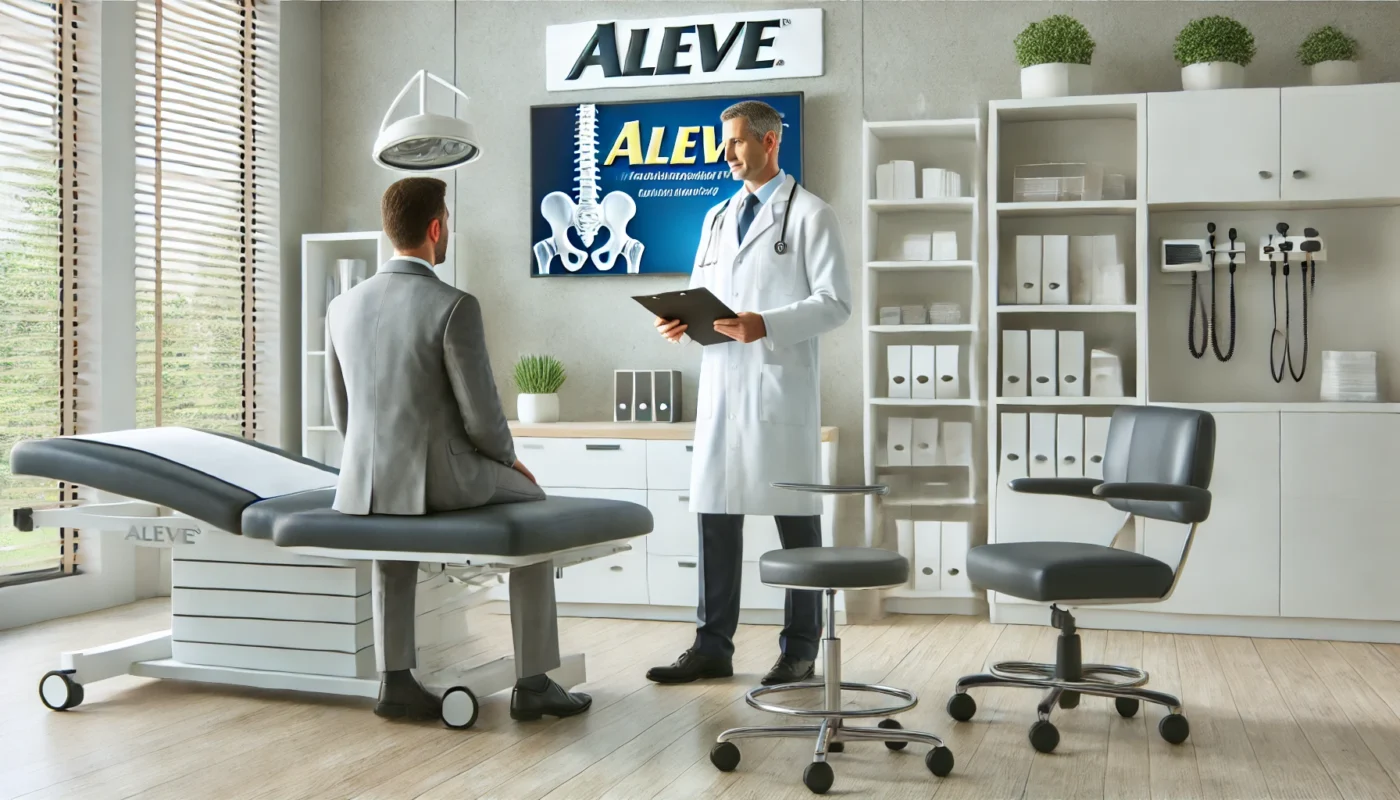Sciatica can be a real pain — quite literally. For those dealing with this condition, finding effective relief is paramount. Aleve, a popular over-the-counter nonsteroidal anti-inflammatory drug (NSAID), is often considered by those seeking relief from sciatica pain. But is Aleve a good option for sciatica relief? Let’s delve into the intricacies of using Aleve for sciatica, explore its potential benefits, and discuss alternative treatments to consider.
You may also like: Understanding Long-Term Pain Relief Options
What is Sciatica?
Sciatica refers to pain that radiates along the path of the sciatic nerve, which extends from the lower back through the hips and buttocks and down each leg. Typically, sciatica affects only one side of the body. The pain can range from mild to severe and is often accompanied by tingling, numbness, or muscle weakness.
Anatomy of the Sciatic Nerve
The sciatic nerve is the longest and widest nerve in the human body, originating from the lower lumbar and sacral spine. It travels through the buttocks and down the legs. Understanding its path can help pinpoint areas susceptible to pressure or injury, which is crucial for effective treatment.
Causes of Sciatica
Sciatica is usually caused by a herniated disk or a bone spur on the spine compressing part of the nerve. This results in inflammation, pain, and often some numbness in the affected leg.
Herniated Disks
A herniated disk occurs when the soft center of a spinal disk pushes through a crack in the tougher exterior casing. This can press on the sciatic nerve, leading to pain.
Bone Spurs and Spinal Stenosis
Bone spurs can develop over time due to osteoarthritis. These bony projections can impinge on the nerve. Similarly, spinal stenosis, or narrowing of the spinal canal, can compress the sciatic nerve.
Other Contributing Factors
Pregnancy, obesity, prolonged sitting, and diabetes are other factors that may contribute to the development of sciatica by either directly or indirectly putting pressure on the sciatic nerve.
Symptoms of Sciatica
- Lower Back Pain: A constant pain in one side of the buttock or leg.
- Leg Pain: Pain that worsens when sitting.
- Burning or Tingling: Sensations down the leg.
- Weakness: Numbness or difficulty moving the leg or foot.
Pain Patterns
Sciatic pain often starts in the lower back and radiates down the back of the thigh and calf. Understanding these patterns can aid in diagnosing the condition.
Sensory Abnormalities
In addition to pain, individuals may experience abnormal sensations such as tingling, pins and needles, or burning along the nerve’s path.
Motor Impairments
Severe cases of sciatica can lead to motor impairments, including difficulty in lifting the foot, known as foot drop, or weakness in the legs, impacting mobility.
How Does Aleve Work?
Aleve is an NSAID that works by reducing hormones that cause inflammation and pain in the body. It’s known for its effectiveness in providing relief from various types of pain, including headaches, muscle aches, and arthritis. But how does it fare when it comes to sciatica?
Mechanism of Action
Aleve contains the active ingredient naproxen, which blocks the production of prostaglandins, substances in the body that mediate inflammation and pain. By inhibiting these chemicals, Aleve can reduce swelling and discomfort.
Aleve for Sciatica Pain
Aleve can be effective in relieving the pain and inflammation associated with sciatica. The active ingredient, naproxen, helps decrease the swelling and pain, offering temporary relief from the discomfort associated with the condition.
Duration and Onset of Relief
Aleve is often chosen for its long-lasting effects, providing relief for up to 12 hours. Understanding the timing can help in managing doses effectively throughout the day.
Temporary Relief Vs. Long-Term Solution
While Aleve offers temporary alleviation from pain, it doesn’t address the underlying causes of sciatica. Its role should be as a part of a broader treatment strategy.
Combining Aleve with Other Treatments
Incorporating Aleve with physical therapy, exercises, and lifestyle changes can enhance its effectiveness and contribute to comprehensive pain management.
Is Aleve Good for Sciatica Pain?
While Aleve can help alleviate the symptoms of sciatica, it is not a cure for the underlying cause of the nerve compression. Therefore, it’s important to use it as part of a comprehensive treatment plan that addresses the root cause of the pain.

Consultation with Healthcare Providers
It’s crucial to consult with healthcare professionals to tailor a treatment plan that includes Aleve as an adjunctive therapy, rather than a standalone solution.
Monitoring and Adjusting Usage
Regular check-ins with a healthcare provider can help monitor the effectiveness of Aleve and adjust dosages or treatment plans as necessary.
Understanding the Limitations
Knowing the limitations of Aleve is vital, as it is primarily a pain-relief medication and not a cure for sciatica. Patients should set realistic expectations for its use.
Safety and Side Effects
Before incorporating Aleve into your pain management regimen, it’s crucial to understand the potential side effects and risks associated with its use. Like other NSAIDs, Aleve can cause side effects such as:
- Stomach Pain: Gastrointestinal issues, including ulcers and bleeding.
- Kidney Issues: Potential impact on kidney function.
- Allergic Reactions: Such as rash, itching, or swelling.
Gastrointestinal Concerns
NSAIDs, including Aleve, can irritate the stomach lining, leading to ulcers or even gastrointestinal bleeding. It’s important to take Aleve with food or antacids to minimize these risks.
Kidney Function Impairment
Long-term use of Aleve can affect kidney function. Patients with pre-existing kidney conditions should use it with caution and under medical supervision.
Allergic Reactions and Sensitivity
Although rare, some individuals may experience allergic reactions to Aleve, presenting as skin rashes, swelling, or difficulty breathing, requiring immediate medical attention.
Precautions
It’s advisable to consult with a healthcare professional before starting Aleve, especially if you have a history of stomach issues, heart disease, or kidney problems. Additionally, long-term use of NSAIDs should be approached with caution.
Pre-Existing Conditions
Individuals with cardiovascular issues, such as high blood pressure, or those with a history of gastrointestinal problems should discuss the risks with their doctor.
Interactions with Other Medications
Aleve can interact with other medications, including blood thinners and certain antidepressants. It’s important to disclose all medications to your healthcare provider.
Monitoring Long-Term Use
For those requiring long-term use of Aleve, regular monitoring through blood tests and health check-ups can help mitigate potential risks.
Alternative Sciatica Treatment Options
While Aleve can provide temporary relief, exploring holistic and alternative treatment options can be beneficial for long-term management of sciatica.
Physical Therapy
Physical therapy can play a significant role in alleviating sciatica pain by strengthening the muscles supporting the spine and improving flexibility.
Tailored Exercise Programs
Physical therapists can design exercise programs specifically tailored to the individual’s needs, focusing on strengthening the core and improving posture.

Techniques for Pain Management
Manual therapy techniques, such as massage and mobilization, can help reduce muscle tension and improve nerve function.
Education and Self-Management
Education on body mechanics and self-management strategies can empower individuals to manage their condition effectively outside of therapy sessions.
Chiropractic Care
Chiropractic adjustments can help alleviate pressure on the sciatic nerve, providing relief from pain.
Spinal Adjustments
Chiropractors use spinal adjustments to realign the vertebrae, reducing nerve compression and alleviating pain.
Complementary Therapies
Many chiropractors offer complementary therapies, such as ultrasound and electrical stimulation, to enhance pain relief and promote healing.
Patient-Centric Approaches
Chiropractic care often involves a holistic approach, considering lifestyle factors and ergonomics in the treatment plan.
Acupuncture
Acupuncture has been shown to relieve sciatica pain by promoting natural healing processes in the body.
Mechanisms of Acupuncture
Acupuncture involves inserting thin needles into specific points on the body to stimulate nerves and release endorphins, the body’s natural painkillers.
Research and Efficacy
Studies have shown that acupuncture can be effective in reducing sciatica pain and improving function, offering a viable alternative or complement to traditional treatments.
Integration with Conventional Medicine
Acupuncture can be integrated into conventional medical treatments, providing a holistic approach to pain management.
Yoga and Stretching
Incorporating yoga and stretching exercises into your routine can improve flexibility and reduce tension in the muscles surrounding the sciatic nerve.
Benefits of Yoga
Yoga promotes relaxation and flexibility, which can reduce stress on the sciatic nerve and improve overall well-being.
Targeted Stretching Routines
Stretching routines focused on the lower back, hips, and legs can alleviate tension and improve mobility, reducing sciatic pain.
Mind-Body Connection
Yoga emphasizes the mind-body connection, encouraging mindfulness and stress reduction, which can positively impact pain perception.
Holistic Approaches to Sciatica Relief
Taking a holistic approach to managing sciatica can enhance overall well-being and provide more sustainable relief.
Nutrition
A diet rich in anti-inflammatory foods can support the body’s natural healing processes. Consider incorporating foods like leafy greens, fatty fish, and nuts into your diet.
Anti-Inflammatory Foods
Incorporating foods high in omega-3 fatty acids, such as salmon and walnuts, can help reduce inflammation and support nerve health.
Vitamins and Minerals
Ensuring adequate intake of vitamins B12 and D, as well as minerals like magnesium, can support nerve function and reduce pain.
Hydration and Detoxification
Staying well-hydrated and incorporating detoxifying foods, like garlic and green tea, can support overall health and inflammation reduction.
Mind-Body Techniques
Mindfulness and meditation techniques can help manage stress, which can exacerbate pain.
Meditation Practices
Regular meditation practices can promote relaxation and reduce the perception of pain by calming the nervous system.
Breathing Exercises
Breathing exercises can enhance lung capacity and oxygenate the blood, promoting relaxation and reducing tension.
Stress Management Strategies
Incorporating stress management techniques, such as visualization and progressive muscle relaxation, can improve emotional resilience and pain tolerance.
Herbal Supplements
Some herbal supplements, such as turmeric and ginger, are known for their anti-inflammatory properties and may support sciatica relief.
Turmeric and Curcumin
Turmeric contains curcumin, a powerful anti-inflammatory compound that can help reduce sciatica pain when taken regularly.
Ginger and Its Benefits
Ginger has natural anti-inflammatory properties and can be consumed as a tea or supplement to support pain relief.
Consulting with Professionals
Before starting any herbal supplements, it’s important to consult with a healthcare provider to ensure they are safe and appropriate for your specific condition.
Conclusion
Aleve can be a helpful component in managing the pain associated with sciatica, but it should not be relied upon as the sole treatment. A comprehensive approach, including physical therapy, alternative therapies, and lifestyle changes, can effectively address the root causes of sciatica and promote long-term relief.

For those considering Aleve for sciatica, consultation with a healthcare professional is essential to ensure safety and efficacy. By understanding the full spectrum of treatment options available, individuals can make informed decisions about their health and well-being. Through a combination of medical treatments, lifestyle adjustments, and holistic approaches, managing sciatica pain can become a more achievable goal.
Further Reading:
17 Strategies To Knock Out Sciatic Nerve Pain
Drugs, Medications, and Spinal Injections to Relieve Sciatica
Chiropractic, Sciatica, Pain Relief, Acupuncture, Yoga, Stretching, Holistic Health, Nutrition, Anti-Inflammatory, Herbal Supplements, Stress Management, Mindfulness, Physical Therapy, Spinal Adjustments, Complementary Therapies
Important Note: The information contained in this article is for general informational purposes only, and should not be construed as health or medical advice, nor is it intended to diagnose, prevent, treat, or cure any disease or health condition. Before embarking on any diet, fitness regimen, or program of nutritional supplementation, it is advisable to consult your healthcare professional in order to determine its safety and probable efficacy in terms of your individual state of health.
Regarding Nutritional Supplements Or Other Non-Prescription Health Products: If any nutritional supplements or other non-prescription health products are mentioned in the foregoing article, any claims or statements made about them have not been evaluated by the U.S. Food and Drug Administration, and such nutritional supplements or other health products are not intended to diagnose, treat, cure, or prevent any disease.

